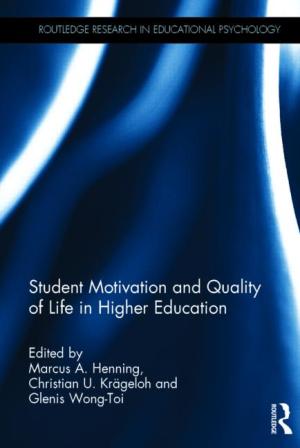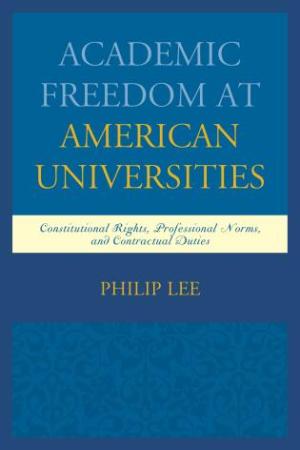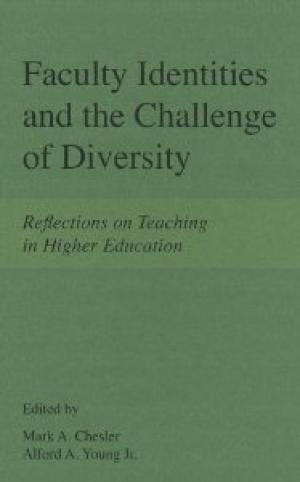Resources by Steve B. Sherman

Student Motivation and Quality of Life in Higher Education provides readers a constructive overview of the relationship between student motivation and quality of life (QOL) in higher education. In five parts comprising twenty-three chapters, the book presents a wide range of topics and emphases. Part I, “Student perspectives,” offers two student case studies (one undergraduate, one graduate), relating their perspectives and experiences as to influences on personal QOL and learning motivation. These reflections set the stage for Parts II through V. Part II focuses on “Theoretical perspectives” concerned with matters of learning motivation, QOL and higher education, and applied positive psychology in higher education (chapters 3-5, respectively). Part III attends to “Diversity perspectives on motivation to learn and quality of life,” containing ten chapters encompassing wide-ranging variables such as international student well-being, higher education views among various nations and people groups, health-related and disability impact on QOL and motivation to learn, and effects of optimism and positive orientation on student well-being and learning. Part IV centers on “Promotion of motivation to learn and quality of life in higher education,” comprising six chapters examining and reflecting on improving academic QOL via counseling, resilience in students and teaching resilience skills via a computer-assisted learning website, eLearning support for mental health and perceived self-efficacy, a peer support program for student well-being, curriculum implications resulting from QOL and motivation and professionalism studies, and reclamation of light and liberty and learning related to higher education and student stress. Part V, the final chapter (23) “Synthesis of motivation to learn and quality of life,” presents the editors’ conclusion and a proposed integrative QOL and student motivation model. Evident strengths of this book include the important (and apparently original) intentional integration of QOL and student motivation, supported with substantive research, reflection, and proposals. Additional strengths of the book include the breadth of the general subject matter and variety of global perspectives. Chapters vary somewhat in terms of research, reflection, and presentation quality (not atypical of edited volumes). One apparent (and somewhat paradoxical) weakness concerns the book’s striving for – and generally achieving – various and useful diversities while also limiting its general ethos to mainly (though not exclusively) medical and health-related students, curricula, and attention. Broadening the research and application to include a wider base of students, disciplines, and curricula (more liberal arts, for instance) would foster greater connectivity within broader academia (undergraduate and graduate) – enhancing the appeal and merit of this already fine tome. Of particular importance is the dynamic “evolving model of education-related quality of life” (210), summarizing well the overall research findings and important reflective and application possibilities pertaining to student motivation and QOL in higher education. The model avoids reductionistic tendencies owing to its complex, symbiotic, and holistic orientation. I recommend this book as a constructive resource for higher education institutions (public and private): the book represents a strong effort toward advancing its stated goal of combining “the concepts of motivation and quality of life with the view to enriching the educational sector” (212).

In Academic Freedom at American Universities,Philip Lee presents a convincing case for transforming higher education with respect to protecting and encouraging true academic freedom of professors – in both public and private university settings. In six chapters, Lee discusses: the crisis of academic freedom in modern universities and the American Association of Universities Professors (chapter 1), the AAUP’s first policy declaration in 1915 and its struggle to defend academic freedom (chapter 2), the AAUP’s seminal 1940 statement and judicially defined academic freedom during the McCarthy era (chapter 3), modern constitutional conceptions of academic freedom (chapter 4), the limitations of constitutionally-based professorial freedom (chapter 5), and contract law as an alternative and better professorial academic freedom (chapter 6), an expounding of the author’s central proposal. Lee chronicles the shortcomings of constitutionally-based academic freedom and appealing to the First Amendment alone, which he seeks to demonstrate has failed to sufficiently protect public institution professors, while not even applying to private university faculty. Thus, Lee proposes an alternative remedy: “developing a body of contractually based academic freedom case law,” which will “greatly expand the ways that courts protect aggrieved professors when their interests diverge with their employers’” while also allowing for “the proper consideration of the custom and usage of the academic community as either expressed or implied contract terms in resolving disputes between universities and professors” (145-46). The author adds that this contract law approach would also entail the courts giving greater attention to specific campus contexts rather than seeking to create universal remedies that inevitably fall short of fitting certain campus settings. Professor Lee’s research demonstrates substantial mastery of the subject matter and relevant materials – no less for matters dating from the pre-AAUP period through its founding and early years of development to its expanding influence and most recent iterations. Lee’s work evidences careful scholarship that includes extensive collecting, scrutinizing, and evaluating of various crucial events, court cases and findings, written opinions, and other relevant materials spanning the AAUP’s organizational history. Particularly insightful is the author’s discussion of the 1918 report on academic freedom in wartime and the report’s multiple contradictions to the 1915 declaration’s principles, culminating in actual “retreat from professional self-identification in deference to the government’s claimed needs during wartime” (33). Also instructive is Lee’s examination of the shift in focus and language between the 1925 and 1940 Conference Statements – mainly from a prescriptive list of university “don’ts” to descriptive university teachers’ rights with the latter’s garnering of widespread acceptance (47) and approval within the bounds of most religious schools as well (64). The author’s writing style is consistently clear and engaging – no mean feat considering the rather technical and procedural materials encompassing much of this book. Philip Lee’s Academic Freedom at American Universities presents an important argument for an alternative – contract law – foundation for professorial freedom in the academy. I recommend the book as a valuable resource for all public and private higher education institutions, particularly their faculty and executive administration.

This book is dedicated to a full-orbed challenge to discrimination – and promotion of multiculturalism – in higher education, from the classroom to “changes in the cultures, structures, and policies of the institution” (194). It will benefit faculty and administrators seeking to better understand, promote, and implement solutions regarding various diversities in university contexts. While Christian educators may question certain philosophical and religious presuppositions being advocated, many descriptive, reflective, and practical insights can be critically embraced for pedagogy and classroom, course development, broader curricular intentions, and governing cultures and mechanisms. Perhaps centrally beneficial to faculty are the narratives of diverse women and men faculty – white and of color, representing both natural science and social science disciplines – responding to a face-to-face interview protocol of open-ended and broad questions: queries seeking responses to eight topical areas primarily focused on teaching and diversity, race and gendered experiences, general diversity issues in higher education, and agential roles in supporting or bringing change involving diversity and multiculturalism (26-28). This work’s broad purpose is to explore how university faculty members of various races, ethnicities, and genders – awarded for undergraduate teaching effectiveness in diverse classroom environments – engage demands and expectations from students, from higher education as a social institution, and from themselves, in racially and ethnically diverse classrooms: especially toward improving the teaching-learning process (viii-ix). The book comprises four parts: background and context, difference and diversity in classroom interactions, identity role examination, and larger contexts and change. Each part contains three chapters. References are extensive and effectively utilized and the index is well-designed. The opening chapter argues that white male dominance in university settings significantly affects white women and faculty of color, as well as students, especially of non-majority groups. Negatively, this includes exclusion and discrimination via traditions that focus on individualistic value orientation and norms that “diminish the importance of teamwork and skills in interactions among the faculty,” leading to a sense of isolation and lack of community (3). In the classroom the individual achievement emphasis, combined with presumed universalistic norms related to tests or criteria as indicators of merit, entail pedagogical approaches that minimize students’ cultural and socioeconomic identities, backgrounds, and relationships, undermining collaborative learning. Nevertheless, all faculty are responsible for personal and organizational change, whether white faculty especially using their authority to adopt practices that challenge the commonplace habitus, or underrepresented faculty utilizing the margin for building communities of marginalized faculty and links to communities and groups outside academia (19). Chapter 2 outlines the project/study design and purpose, “to explore the ways in which faculty members’ social identities impact their experience in the university, especially but not solely in the classroom” (21), while Chapter 3 describes and elaborates “five major constitutive elements of conflict in the educational setting” – the instructor, the student, the pedagogical approach, the classroom space, and the course material – that help readers decipher “how varied forms of conflict emerge given the different ways in which these elements converge” (39). Each element is expounded in later chapters. It seems appropriate to conclude this review with a primary thesis of the book: “ultimately, whatever the causes of perceived challenges to authority and expertise, the key pedagogical dilemma for faculty is to work at ensuring and preserving the authority that has a place in relationships with students while also maintaining an inquiring, empowering, and vibrant educational climate” (63).